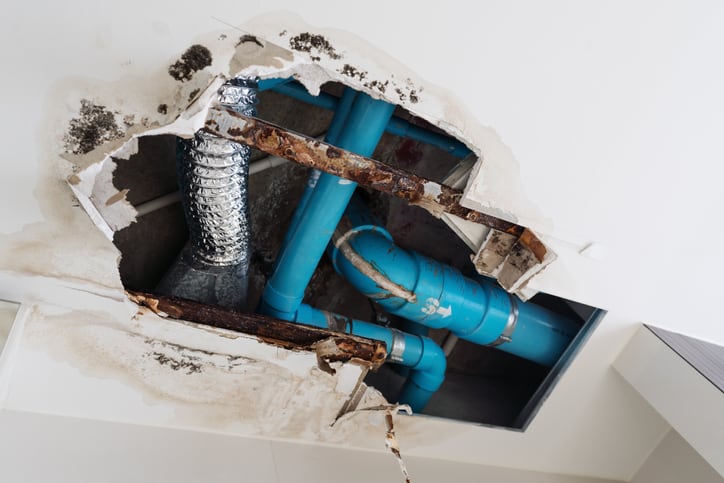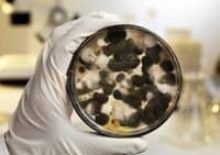
Water damage to a restroom ceiling caused by leaking pipes
Moisture and Mold Inspections
Employee or tenant complaints about water damage? Worry your building might have moisture intrusion or mold problems? See leaks, drips, or water stains? Smell “musty,” or moldy smells? It’s time for a moisture & mold inspection and possibly mold testing.
Water damage in buildings and mold growth go together. A small roof leak, window condensation, faulty gutters, poor drainage, or leaky plumbing can start small but quickly create major problems in any building. Identifying the extent of water damage and eliminating the source of moisture is key, and that requires a trained mold expert, the right equipment, and sometimes mold testing.
Healthy Building Science quickly and safely finds sources of moisture and mold using flashlights, thermal imaging (IR) cameras, and moisture meters. We identify the extent of water damage and microbial growth then report how to address discovered issues. We provide mold sampling and lab analysis if it adds value to the case. With our report, your contractor or builder knows how to go beyond superficial repairs and get to the root cause of damage.
Upon request, HBS will write a detailed Mold Remediation Protocol (MRP) outlining requirements for the safe removal of mold from a building. Mold Remediation Protocols are detailed instructions outlining safety requirements and scope of work for your specific mold remediation project. Our MRPs are designed in accordance with industry-accepted standards (IICRC S520 Mold Remediation Standard).
Clearance mold testing services are available following a mold inspection and mold mitigation. Mold clearance inspections are common when insurance is involved or when you need to be certain an area was successfully remediated. We also offer air quality mold testing lab interpretation.
 We are committed to helping all our customers, and we take special precautions to protect those with asthma or Multiple Chemical Sensitivity (MCS). Our industrial hygiene team does not wear offensive fragrances.
We are committed to helping all our customers, and we take special precautions to protect those with asthma or Multiple Chemical Sensitivity (MCS). Our industrial hygiene team does not wear offensive fragrances.
Bay Area Mold Survey Success Stories
Office Mold Inspection: A medical packaging plant had recently installed a new Reverse Osmosis (RO) water filtration system. Ironically, the RO system leaked in the walls and did more harm than good. We performed a mold inspection and defined the scope of work. We performed air quality monitoring during remediation, and mold clearance testing upon project completion. In the end, the company had sufficient documentation to satisfy their investors and regulatory agencies that they had done their due diligence and fully contained and mitigated the mold problem. We helped to minimize their downtime with a speedy response, and they were happy their employees were given peace of mind after our inspectors reported their final findings.
Home Mold Inspection: A client with severe mold allergies suffered inexplicably in two rooms of her fiance’s home in San Jose. During our mold inspection, we found four sources of moisture and three places with active mold growth of which the client was unaware. A week after her contractor had fixed the moisture issues and removed the mold, we got a call saying she could finally be comfortable in her fiance’s home. We may have even saved their marriage!
Mold Assessment and Testing
Mold testing and mold inspections are a combination of art and science. Many people jump right to mold testing. However, experts do not always recommend spending money and time on mold lab analysis. There is a time and a place for strategic sampling plans, but a mold expert will first recommend a thorough building inspection prior to developing a sampling plan.
Any qualified industrial hygienist or expert mold consultant will confirm that a mold assessment is a top priority. By using a flashlight, IR camera and moisture meter, two eyes and a nose, a good mold inspector can usually tell you whether mold is present, and often they can draw conclusions as to whether it could be toxic mold. Sampling in the absence of a thorough moisture and mold inspection is not recommended, and the data collected from such sampling is missing context and next to meaningless.
Healthy Building Science advocates the following steps:
- A qualified, professional mold expert should provide a thorough moisture and mold inspection of the building.
- Formulate hypothesis as to the presence of moisture, sources of moisture, and extent of water and mold damaged materials.
- Determine if sampling would add value to the mold assessment, or not (skip to #6, if not).
- Develop a sampling plan to test the hypothesis.
- Sample and review data.
- Report on findings from inspection, hypothesis developed, sampling results, and conclusion for next steps. Restart from #2 (refine hypothesis) if necessary.
If your mold inspector doesn’t offer a comprehensive moisture assessment, pushes a lot of biological testing, or does microbial testing and only shares the lab results without a clear interpretation of their meaning, they are not providing value or helping your cause. Unfortunately, the do-it-yourself petri-dish style testers are not recommended in the absence of a professional mold investigation.
Microbial lab testing is useful for:
- Determining the relative toxicity of mold species in presence of symptoms or sensitive populations,
- Establishing a baseline prior to remediation,
- Determining the scope of mold contamination,
- Clearance testing after remediation to confirm an area is clean, and last but not least,
- Peace of mind for those concerned.
Mold Testing Methods
Most mold consultants will perform a mold survey that includes some form of microbial lab analysis. Like testing for any pollutant, there are myriad ways to collect samples and have them analyzed in the lab. Some more common testing methods include:
-
Airborne mold spore trap
A known amount of air is drawn over an adhesive slide. The slide is analyzed by lab technicians who extrapolate a “spore per cubic meter” number for each sample. Spores are identified to the genus level, but not to the species level. Penicillium and Aspergillus cannot be distinguished between each other in this particular microscopic analysis. Comparing indoor and outdoor samples, we can draw conclusions about airborne spore counts in the building.
-
Bulk mold testing
A tape lift, swab or bulk building material, such as a small sample of drywall, is analyzed through a microscope. This method has the same genus level id limitations as a spore trap.
-
Environmental Relative Moldiness Index (ERMI) or Polymerase Chain Reaction (PCR)
This method utilizes microbial DNA analysis to identify mold to the species level, but relatively few species have been cataloged so this rapid testing method can miss a majority of molds present. Environmental doctors and naturopaths are familiar with this method and it has gained more traction in recent years.
-
Mold culturing
Viable mold spores are sent to a testing lab and cultured. The spores are placed on Petri dishes with a selected growth medium, sufficient moisture is provided and temperatures are regulated simulating optimal growing conditions. Some spores may be present (and toxigenic and allergenic) but not viable and therefore do not grow and colonize. Mold colonies that do form are identified to the species level. This form of analysis takes longest of all options presented here and fewer testing labs offer this method.
Mold Assessment and Inspection Benefits
Moisture problems generally don’t fix themselves, and as moisture continues to damage building materials the extent of water damage and costs of remediation increase by the day. As microbial growth spreads so does the risk of cross-contamination and health symptoms related to occupant exposures. Therefore finding the source and fixing water intrusion quickly is of paramount importance to occupants and building owners.
Whether mold tests are for clearance testing, to determine the extent/type of contamination, or simply to provide peace of mind – sometimes it’s the only way to add a level of certainty that is otherwise impossible without professional mold lab analysis.
Water Damage Assessments for San Francisco Bay Area
We presently have mold inspectors located in Berkeley, Oakland, Sebastopol, San Rafael, and San Francisco.
Bay Area Mold Consultant Case Studies
- Cupertino office mold inspection
- San Jose mold testing for a home inspection
- Santa Rosa mold expert witness support
- San Francisco mold consulting for retail stores
- Sunnyvale mold air testing for a data center
- Fremont mold assessment for a manufacturing facility
- Oakland moisture survey for multi-family residential buildings
- San Francisco affordable housing mold consulting
- Walnut Creek microbial survey for a medical office
- Sacramento mold inspection for an office
Mold Inspections San Francisco Bay Area
Healthy Building Science is an environmental consulting firm providing mold inspection services for commercial, residential, multi-family buildings, offices, industrial and manufacturing workplaces, hospitals and medical facilities, and single-family homes in the greater San Francisco Bay Area and Northern California. Cities we service include San Francisco, San Jose, Oakland, Sacramento, Santa Rosa, Hayward, Sunnyvale, Fremont, Concord, Salinas, Santa Clara, Berkeley, Vallejo, Fairfield, Antioch, Richmond, Daly City, San Rafael, San Mateo, Vacaville, San Leandro, and Livermore and Alameda County, Contra Costa County, Marin County, Napa County, San Mateo County, Santa Clara County, Solano County and Sonoma County.
What are you waiting for? Let our industrial hygienists help with all your mold inspection needs!




